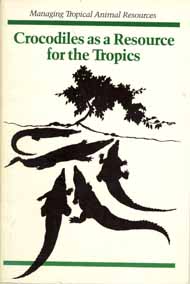Page Header
[ Enter you text here. ]
LIVESTOCK THAT REMAIN OVERLOOKED
Like computers, livestock for use in developing countries should be getting smaller and more “personal.” Poor farmers in the Third World have to live off what they can produce from farmsteads commonly covering less than an acre. Thus to boost protein production in the tropics, more attention must be given to species the rural poor can produce on their own tiny plots.
Small user-friendly species can provide subsistence farmers with both income and nutrition. Their nutritional importance rests on the fact that today Latin America, Asia, and Africa’s poor seldom eat meat, milk, or eggs. As a result, malnutrition is common and protein deficiency, especially in children, is debilitating and the second major cause of malnutrition deaths.
Microlivestock; Little-Known Small Animals with a Promising Economic Future is a 447-page eye-catching book describing more than 40 species that are sized for poor-people’s space limitations. Included are small breeds of cattle, sheep, goats, pigs, eight types of poultry, a dozen rodent species (all currently eaten), not to mention dwarf deer, dwarf antelope, rabbits, iguanas, and bees.
$10.00, Buy Now
Small Animals are Beautiful Too
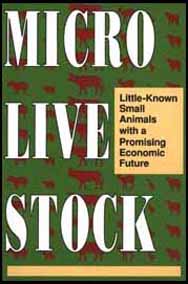
Maybe you’ve heard of yak, but how about banteng, madura, mithan, kouprey, babirusa, warty pigs? These and other obscure animals are indigenous to Asia. All are used (or at least hunted) for food; some are domesticated and used as beasts of burden.
Most of these unusual species are vital to rural life in select parts of South East Asia; even the undomesticated ones have qualities suggesting they could contribute more to rural development. Even partial domestication would boost the survival of species that now being mindlessly destroyed by hunters or poachers. A few might possibly find global utility as farm creatures.
Several of the species are receiving study for essentially the first time. In recent years banteng and babirusa (a possible “kosher pig”) have all come in for scientific scrutiny. The kouprey, a cattle relative with billion-dollar potential, has spawned rescue efforts but has perhaps gone extinct in our lifetime.
Little-Known Asian Animals with a Promising Economic Future is a 124-page eye-opener that exposes these amazing creatures that are related either to cattle, to pigs or to nothing we know. A fun read, it induces the imagination to play with the possibilities.
$5.00, Buy Now
The Strangest of all Livestock
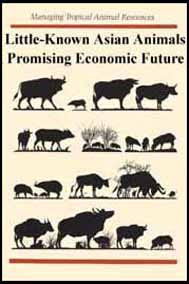
Perhaps the most misunderstood of all animal resources, the water buffalo has in recent years performed notably well in such unexpected places as the United States, Australia, and Brazil.
When it comes to this animal, peasants have always been way ahead of policymakers. This is a poor-person's patron. It lives off the straw while people live off the grain. It is gentle, friendly, and a major contributor. “If I die, my family will weep for me,” a Chinese woman once explained, “but if the buffalo dies, they'll starve.”
The Water Buffalo: New Prospects for an Underutilized Animal is a vividly illustrated 118-page book that emphasizes the potential beyond Asia. Published in 1981, it provided the scientific credibility that helped attract serious researchers to a neglected animal. The meat has proved to be lean and low in cholesterol; the milk is top rate, being the source of mozzarella cheese.
Brazil already has more than 4 million head, and Asia’s water buffaloes like the Amazon basin's heat and humidity. Unfazed by periodic floods, they swim well and eat the plants under water.
$5.00, Buy Now
The Most Lovable Beast of Burden
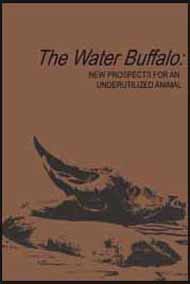
To outsiders, butterfly farming may seem a frivolous activity. But the world desperately needs “livestock” that can be raised on or amid tropical trees. Presently, rainforests are being cut down so that cattle can be raised. With animal resources that need trees the same farmers will foster, rather than fell, the forests. Such a program in Papua New Guinea helps people in remote villages "grow their own" colorful and very valuable livestock from the native bush in their neighborhood.
Tropical butterflies are brightly colored charmers whose worth is measured by the ounce. Their farm is the forest, so their propagation and preservation adds value to the standing trees.
Horticulture, not entomology, is the key. In PNG, villagers enrich the local farmlands and forest fringes with the plants the insects need to complete their life cycles. Butterflies then emerge from the forest and lay hundreds of eggs and (given care and skill) the “farmer” is soon harvesting bumper crops of six-legged livestock.
Butterfly Farming in Papua New Guinea is a bright, colorful 34-page booklet that lays out the procedure. Its five chapters include: Operating a Butterfly Farm and Application to Other Nations. This tool is universal, beneficial, simple, and stunning to see.
$5.00, Buy Now
Winged Wildlife Farming
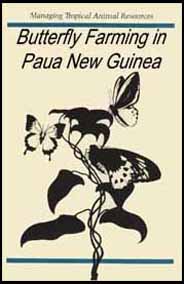
Crocodiles are both an integral part of the tropical ecosystem and a potentially renewable natural resource of considerable economic value. Not long ago these biologically interesting creatures were also among the most endangered of the earth's animals. Populations worldwide were plummeting. The prime cause: excessive and mostly illegal hunting for the valuable skins.
Printed in 1983, the 55-page Crocodiles as a Resource for the Tropics helped turn that around. It highlights a Papua New Guinea program in which breeding-age crocodiles are legally protected and locals are encouraged to harvest each year’s new generation. Those hatchlings tend to be abundant, timid and easy to catch. Villagers raise them in their backyards for a couple of years and then sell the skins, which bring several hundred dollars apiece—a fortune in local terms.
This “ranching” method encourages everyone to maintain the wild stock as well as its habitat, which is after all the source of their livelihood and their future. The method therefore engages economic self-interest to protect endangered species in their natural environment.
$5.00, Buy Now
Putting Crocodiles in their Place
